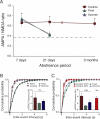Cocaine but not natural reward self-administration nor passive cocaine infusion produces persistent LTP in the VTA
- PMID: 18667156
- PMCID: PMC2593405
- DOI: 10.1016/j.neuron.2008.05.024
Cocaine but not natural reward self-administration nor passive cocaine infusion produces persistent LTP in the VTA
Abstract
Persistent drug-seeking behavior is hypothesized to co-opt the brain's natural reward-motivational system. Although ventral tegmental area (VTA) dopamine (DA) neurons represent a crucial component of this system, the synaptic adaptations underlying natural rewards and drug-related motivation have not been fully elucidated. Here, we show that self-administration of cocaine, but not passive cocaine infusions, produced a persistent potentiation of VTA excitatory synapses, which was still present after 3 months abstinence. Further, enhanced synaptic function in VTA was evident even after 3 weeks of extinction training. Food or sucrose self-administration induced only a transient potentiation of VTA glutamatergic signaling. Our data show that synaptic function in VTA DA neurons is readily but reversibly enhanced by natural reward-seeking behavior, while voluntary cocaine self-administration induced a persistent synaptic enhancement that is resistant to behavioral extinction. Such persistent synaptic potentiation in VTA DA neurons may represent a fundamental cellular phenomenon driving pathological drug-seeking behavior.
Figures





References
-
- Bäckström P, Hyytiä P. Ionotropic and metabotropic glutamate receptor antagonism attenuates cue-induced cocaine seeking. Neuropsychopharm. 2006;31:778–786. - PubMed
-
- Bellone C, Lüscher C. Cocaine triggered AMPA receptor redistribution is reversed in vivo by mGluR-dependent long-term depression. Nat. Neurosci. 2006;9:636–641. - PubMed
-
- Borgland SL, Taha SA, Sarti F, Fields HL, Bonci A. Orexin A in the VTA is critical for the induction of synaptic plasticity and behavioral sensitization to cocaine. Neuron. 2006;49:589–601. - PubMed
Publication types
MeSH terms
Substances
Grants and funding
LinkOut - more resources
Full Text Sources
Other Literature Sources

